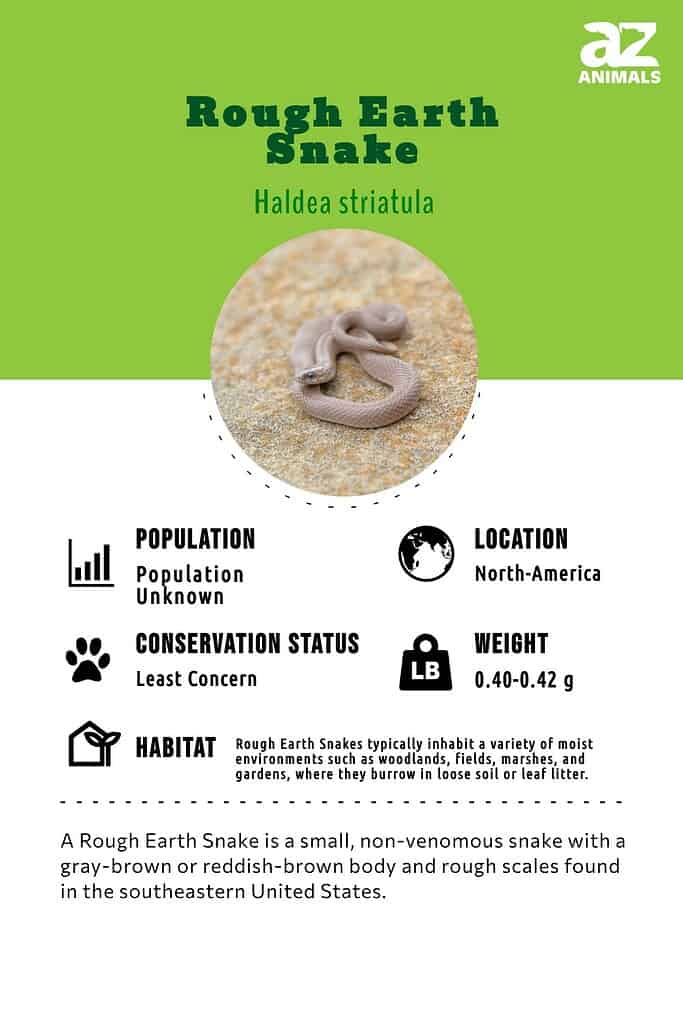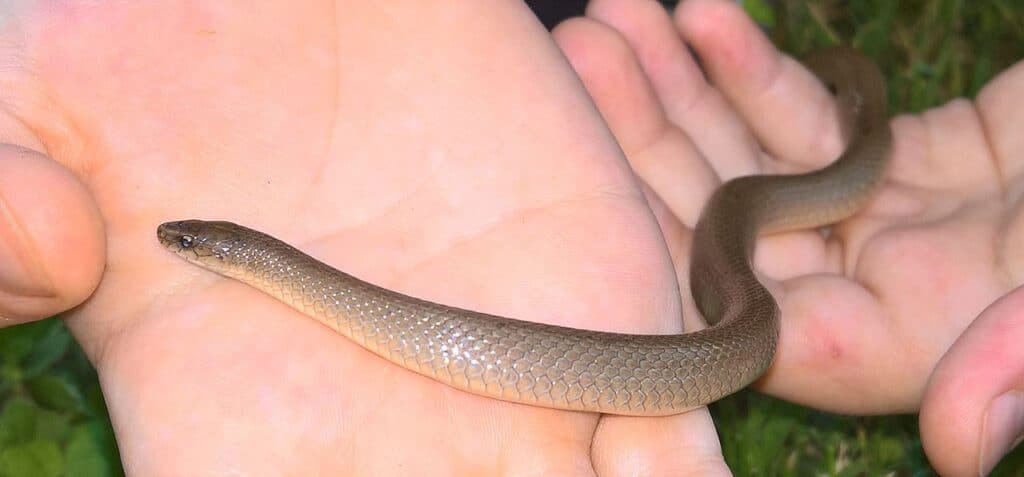Rough Earth Snake
Haldea striatula
It has a pointed snout that is uses to burrow into moist soil.
Advertisement
Rough Earth Snake Scientific Classification
- Kingdom
- Animalia
- Phylum
- Chordata
- Class
- Reptilia
- Order
- Squamata
- Family
- Colubridae
- Genus
- Haldea
- Scientific Name
- Haldea striatula
Read our Complete Guide to Classification of Animals.
Rough Earth Snake Conservation Status
Rough Earth Snake Facts
- Prey
- Earthworms, slugs, snails, sow bugs, insect eggs, and larvae.
- Main Prey
- Earthworms
- Name Of Young
- Neonates
- Group Behavior
- Solitary except during mating season
- Fun Fact
- It has a pointed snout that is uses to burrow into moist soil.
- Other Name(s)
- Brown ground snake, brown snake, ground snake, little brown snake, little striped snake, small brown viper, small-eyed brown snake, southern ground snake, striated viper, and worm snake
- Litter Size
- 3-8
- Diet
- Omnivore
- Lifestyle
- Nocturnal
- Diurnal
- Favorite Food
- Earthworms
Rough Earth Snake Physical Characteristics
- Skin Type
- Scales
- Lifespan
- 5-7 years
- Length
- 7-10 inches
- Venomous
- No
- Aggression
- Low
View all of the Rough Earth Snake images!

This nonvenomous snake is small and slender; it prefers staying hidden under the leaf litter, rocks, and compost piles, where it will live most of its life. Rough earth snakes are so small they are sometimes mistaken for the worms they love to eat.
Incredible Rough Earth Snake Facts

©Creeping Things/Shutterstock.com
- Juvenile rough earth snakes are often confused for ring-necked snakes because they have a light band behind their head.
- They don’t constrict their prey and swallow it still alive.
- Rough earth snakes have keeled scales and are often confused for De Kay’s brown snake.
Scientific Name and Classification
The rough earth snake’s current scientific name is Haldea striatula. Like many organisms, this species has changed names several times over the years. Since its first description in 1766 by Carl Linnaeus with the name Coluber striatulus, these snakes have been classified into several genera, including Natrix, Conocephalus, Falconeria, and Virginia.
In the early 2000s, genetic research results showed that many reptiles had been classified into genera that didn’t fit precisely, so scientists moved them. The most recent change was in 2013 when scientists changed the generic name back from Virginia to Haldea.
They have several common names, including brown snake, ground snake, brown ground snake, little striped snake, small brown viper, small-eyed brown snake, southern ground snake, striated viper, and worm snake.
Here are some different types:
- Brown snake
- Ground snake
- Brown ground snake
- Little striped snake
- Small brown viper
- Small-eyed brown snake
- Southern ground snake
- Striated viper
- Worm snake
Evolution and Origins
The rough earth snake is a fossorial animal that hides in leaf litter, compost piles, gardens, or behind logs, boulders, or decorative stones. The plant can be found in many urban locations as well as a range of woodland settings with a lot of ground cover.
A non-venomous natricine colubrid snake species native to the southeastern United States is the rough earth snake (Virginia striatula). Carolus Linnaeus first identified it as Coluber striatulus in 1766. From Texas to Florida and further north in Missouri, Virginia, and Arkansas, it can be found.
While there isn’t a ton of information about the origins of the rough earth snake, however, the evolutionary history of snakes consists of the earliest known fossils dating to between 143 and 167 Ma ago, snakes are assumed to have developed from either burrowing or aquatic lizards, possibly during the Jurassic period.
Appearance

These snakes are typically brown with white or yellowish bellies
©Kyle Wiering / Creative Commons – License
The rough earth snake measures 7-10 inches as an adult. The females are usually longer and heavier than the males, but otherwise, there’s little visible difference. This snake doesn’t typically have a pattern but is a solid brown, reddish, or gray color with slightly keeled scales, and a tan to whiteish-colored belly. Its snout is pointed, which helps it root around and burrow into moist soil.
Juveniles have light-colored collars and look somewhat like ring-necked snakes. However, unlike ring-necked snakes, rough earth snakes have drab belly colors, and their neck collars don’t fade as they grow.
In general, rough earth snakes are most likely to be mistaken for De Kay’s brown snake, which is generally a little bigger, with a more rounded snout and light brown and dark markings on its back and neck.
Behavior
This species is very shy and reclusive; it’s not at all aggressive, has no venom, and is completely harmless when encountered. It has teeth, however, doesn’t bite anything except its prey. The rough earth snake’s typical response to a threat is first to sit still, then attempt escape. Finally, it musks the individual threatening it. When a snake musks you, it’s defecating on you. It smells awful and is an effective defense against would-be predators.
Depending on the region, rough earth snakes are generally active beginning in early spring and brumate through the colder months beginning in fall. The further north the snakes live, the shorter their active cycle.
Although they’re typically most active during the day, warm wet weather conditions will also bring them out at night. To avoid the heat of the summer, they switch to more nocturnal habits.
Habitat
Rough earth snakes inhabit a wide area of the southeastern United States. They’re found in fourteen states from North Carolina, south to Florida, and west to Texas. These secretive snakes are most often seen in the spring and fall when they’re most likely to be moving to or from brumation sites and breeding.
A fossorial species, the rough earth snake hides under rocks, logs, ornamental stones, in compost piles, and leaf litter. It rarely ventures out in the open and prefers to stay hidden. They’re also found in trash piles, garden beds, and various forested habitats with plenty of ground cover. These snakes use their pointed snouts to help dig through loose soil and debris as they search for prey.
Diet
The rough earth snake is one of many snakes that help control the insect population. They help prevent snails and slugs from overtaking your garden, as their diet is completely made up of invertebrates. Its favorite food is earthworms, but it also eats snails, slugs, insect eggs, sow bugs, and larvae. This tiny predator doesn’t bother to subdue its prey and simply swallows it.
Predators, Threats, Conservation, and Population
While they are predators, earthquakes are not apex predators. Their small size means they become food for many larger animals. Other snakes, predatory birds, and mammals will eat them, given the chance.
According to the IUCN Redlist of Threatened Species, rough earth snakes aren’t in any danger of becoming extinct. The 2007 assessment determined that they have a stable population that thrives, even in urban gardens and parks.
These snakes are pretty flexible in where they live, and whether it’s an urban area or a forest doesn’t seem to make a difference to rough earth snakes. They enjoy a wide distribution across the southeastern United States and are fairly tolerant of habitat changes. All one of these really needs to thrive is a dark, moist location with lots of invertebrates to eat and places to hide.
Reproduction, Babies, and Lifespan
Rough earth snakes mate in the spring, between March and May or June, the more northern populations tend to breed later in spring than their southern cousins. Between June and September, the females give birth to between three and eight four-inch-long babies. Not much is known about their lifespan, but if it’s like similar snakes, they may live up to about seven years.
View all 114 animals that start with RRough Earth Snake FAQs (Frequently Asked Questions)
What's the difference between a rough earth snake a smooth earth snake?
The most obvious difference is that rough earth snakes have lightly keeled scales and smooth earth snakes are smooth.
Where do rough earth snakes live?
They have a wide range in the southeastern United States, and aren’t picky about city or countryside. They only thing they need is a moist place to hide where they can hunt for their favorite food.
How do rough earth snakes hunt?
These snakes go looking for their food. They have a pointed snout that helps them dig through loose soil to find earthworms and other invertebrates.
How big are rough earth snake eggs?
These snakes don’t lay eggs. They give birth from three to eight (on average) live little babies. The newborn snakes only measure about 4 inches long.
Thank you for reading! Have some feedback for us? Contact the AZ Animals editorial team.
Sources
- Breukelman, John 1940. The snake Haldea striatula in Kansas. Herpetologica 2 (2): 56 , Available here: https://www.jstor.org/stable/3890476
- Haldea striatula | Reptarium Reptile Database, Available here: https://reptile-database.reptarium.cz/species?genus=Haldea&species=striatula
- Hammerson, G.A. 2016. Haldea striatula. The IUCN Red List of Threatened Species 2016: e.T64002A90070320. https://dx.doi.org/10.2305/IUCN.UK.2016-1.RLTS.T64002A90070320.en. Accessed on 15 September 2022., Available here: https://www.iucnredlist.org/species/64002/90070320
- Rough earth snake, Missouri Department of Conservation, Available here: https://mdc.mo.gov/discover-nature/field-guide/rough-earthsnake

















